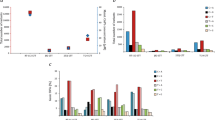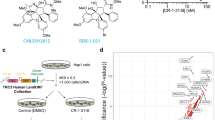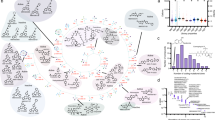Abstract
Dominantly acting mutations that eliminate the allosteric regulation of CTP synthetase confer a form of multidrug resistance and a mutator phenotype to cultured Chinese hamster ovary cells. Mutations responsible for this phenotype have been identified in 23 independent strains selected for resistance to arabinosyl cytosine and 5-fluorouracil. All these mutations were due to base substitutions at seven sites within a highly conserved region of the ctps gene. This clustering should make it feasible to assess the role of such mutations in the development of drug resistance encountered in the treatment of malignant disease.
This is a preview of subscription content, access via your institution
Access options
Subscribe to this journal
Receive 12 print issues and online access
$209.00 per year
only $17.42 per issue
Buy this article
- Purchase on Springer Link
- Instant access to full article PDF
Prices may be subject to local taxes which are calculated during checkout
Similar content being viewed by others
References
Bradley, G., Jaranka, P.F. & Ling, V. Mechanism of multidrug resistance. Biochim. Biophys. Acta 948, 87–128 (1988).
Pastan, I. & Gottesman, M.M. Multidrug resistance. Ann. Rev. Med. 42, 277–286 (1991).
Meuth, M. The molecular basis of mutations induced by deoxyribonucleotide triphosphate pool imbalances in mammalian cells. Exp. Cell. Res. 181, 305–316 (1989).
McPartland, R.P. & Weinfeld, H. Cooperative effects of CTP on calf liver CTP synthetase. J. biol. Chem. 254, 11394–11398 (1979).
Meuth, M., L'Heureux-Huard, N. & Trudel, M. Characterization of a mutator gene in Chinese hamster ovary cells. Proc. natn. Acad. Sci. U.S.A. 76, 6505–6509 (1979).
Meuth, M., Goncalves, O. & Trudel, M. The genetic consequences of the Thy-mutation to CHO cells. in Genetic Consequences of Nucleotide Pool Imbalance (ed de Serres, F.J.) 297–312 (Plenum Press, New York, 1985).
Robert de Saint Vincent, B. & Buttin, G. Studieson 1-β-D-arabinosylcytosine-resistant mutants of Chinese hamster fibroblasts IV: altered regulation of CTP synthetase generates arabinosylcytosine and thymidine resistance. Biochim. Biophys. Acta 610, 352–359 (1980).
Meuth, M., Trudel, M. & Siminovitch, L. Selection of Chinese hamster cells auxotrophic for thymidine by 1 -β-D-arabinosyl cytosine. Somat. Cell Genet. 5, 303–318 (1979).
Meuth, M., Goncalves, O. & Thorn, P. A selection system specific for the thy mutator phenotype. Somat. Cell Genet. 8, 423–432 (1982).
Aronow, B., Watts, T., Lassetter, J., Washtien, W. & Ullman, B. Biochemical phenotype of 5-fluorouracil-resistant murine T-lymphoblasts with genetically altered CTP synthetase activity. J. biol. Chem. 259, 9035–9043 (1984).
Kaufman, E.R. Altered CTP synthetase activity confers resistance to 5-bromodeoxyuridine toxicity and mutagenesis. Mut. Res. 161, 19–27 (1986).
Meuth, M. Role of deoxynucleoside triphosphate pools in the cytotoxic and mutagenic effects of DNA alkylating agents. Somat. Cell Genet. 7, 89–102 (1981).
Chu E, H.Y., McLaren, J.D., Li, I.-C. & Lamb, B. Pleiotropic mutants of Chinese hamster cells with altered cytidine 5′-triphosphate synthetase. Biochem. Genet. 22, 701–715 (1984).
Momparler, R.L. & Onetto-Pothier, N. Drug resistance to cytosine arabinoside. in Resistance to antineoplastic drugs (ed. Kessel, D.) 354–367 (CRC Press, Boca Raton, Florida, 1989).
Yamauchi, M., Yamauchi, N. & Meuth, M. Molecular cloning of the human CTP synthetase gene by functional complementation with purified human metaphase chromosomes. EMBO J. 9, 2095–2099 (1990).
Trudel, M., Van Genechten, T. & Meuth, M. Biochemical characterization of the hamster Thy mutator gene and its revertants. J. biol. Chem. 259, 2355–2359 (1984).
Kelsall, A. & Meuth, M. Direct selection of Chinese hamster ovary cells deficient in CTP synthetase activity. Somat. Cell molec. Genet. 14, 149–154 (1988).
Weng, M., Makaroff, C.A. & Zalkin, H. Nucleotide sequence of Eschericia coli pyrG encoding CTP synthetase. J. biol. Chem. 261, 5568–5574 (1986).
Ozier-Kalogeropoulos, O., Fasiolo, F., Adeline, M.-T., Collin, J. & Lecroute, F. Cloning sequencing and characterization of the Saccharomyces cerevisiae URA7 gene encoding CTP synthetase. Molec. gen. Genet. 231, 7–16 (1991).
Drobetsky, E.A., Grosovsky, A.J. & Glickman, B.W. The specificity of UV-induced mutations at an endogenous locus in mammalian cells. Proc. natn. Acad. Sci. U.S.A. 84, 9103–9107 (1987).
Yamauchi, M. et al. Genomic organization and chromosomal localization of the human CTP synthetase gene (CTPS). Genomics 11, 1088–1096 (1991).
Kang, G.J. et al. Cyclopentenylcytosine triphosphate formation and inhibition of CTP synthetase. J. biol. Chem. 264, 713–718 (1989).
Phear, G., Armstrong, W. & Meuth, M. The molecular basis of spontaneous mutation at the aprt locus of hamster cells. J. molec. Biol. 209, 577–582 (1989).
Zhang, L.H., Vrieling, H., van-Zeeland, A.A. & Jenssen, D. Spectrum of spontaneously occurring mutations in the hprt gene of V79 Chinese hamster cells. J. molec. Biol. 223, 627–635 (1992).
Hollstein, M., Sidransky, D., Vogelstein, B. & Harris, C.C. p53 mutations in human cancers. Science 253, 49–53 (1991).
Levine, A.J., Momand, J. & Finlay, C.A. The p53 tumour suppressor gene. Nature 351, 453–456 (1991).
Lane, D.P. & Benchimol, S. p53: oncogene or anti-oncogene?. Genes Dev. 4, 1–8 (1990).
Adair, G.M., Nairn, R.S., Brotherman, K.S. & Siciliano, M.J. Spontaneous CHO APRTheterozygotes reflect high frequency, allele-specific deletion of the chromosome Z4 APRT gene. Somat. Cell molec. Genet. 15, 535–544 (1989).
Bradley, W.E.C. & Letovanec, D. High-frequency nonrandom mutational event at the adenine phosphoribosyltransferase (aprt) locus of sib-selected CHO variants heterozygous for aprt. Somat. Cell Genet. 8, 51–66 (1982).
Dewyse, P. & Bradley, W.E.C. High-frequency deletion event at aprt locus of CHO cells: Detection and characterization of endpoints. Somat. Cell molec. Genet. 15, 19–28 (1989).
Frohman, M.A., Dush, M.K. & Martin, G.R. Rapid production of full-length cDNAs from rare transcripts: amplification using single gene-specific oligonucleotide primer. Proc. natn. Acad. Sci. U.S.A. 85, 8998–9002 (1988).
Orita, M., Suzuki, Y., Sekiya, T. & Hayashi, K. Rapid and sensitive detection of point mutations and DNA polymorphisms using the poiymerase chain reaction. Genomics 5, 874–879 (1989).
Trach, K., Chapman, J.W., Piggot, P., Lecoq, D. & Hoch, J.A. Complete sequence and transcriptional analysis of the spoOF region of the Bacillus subtilis chromosome. J. Bacteriol. 170, 4194–4208 (1988).
Author information
Authors and Affiliations
Rights and permissions
About this article
Cite this article
Whelan, J., Phear, G., Yamauchi, M. et al. Clustered base substitutions in CTP synthetase conferring drug resistance in Chinese hamster ovary cells. Nat Genet 3, 317–322 (1993). https://doi.org/10.1038/ng0493-317
Received:
Accepted:
Issue Date:
DOI: https://doi.org/10.1038/ng0493-317
This article is cited by
-
Specific selection of deoxycytidine kinase mutants with tritiated deoxyadenosine
Biochemical Genetics (1995)
-
Specific selection of deoxycytidine kinase mutants with tritiated deoxyadenosine
Biochemical Genetics (1995)



